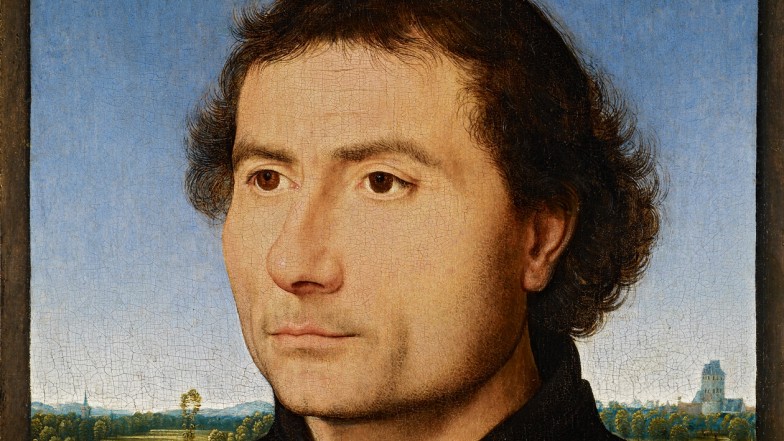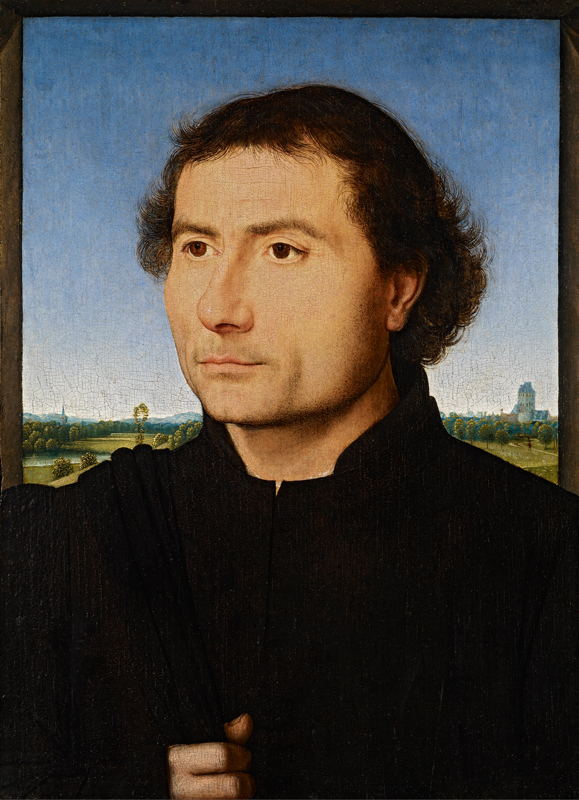Memling's "Portrait of a Man" on Loan from The Frick Collection
Hans Memling’s brilliance as one of the most formative Early Netherlandish painters is clearly evident in The Frick Collection’s panel Portrait of a Man, from the mid-1470s. From January through April, this enigmatic image will reside in the Early Renaissance gallery alongside the Norton Simon Foundation’s own religious panel by Memling, Christ Giving His Blessing, from around 1478. The remarkable quantity of Memling’s extant portraits—in all, about fifty of the hundred or so panels that have been attributed to his hand or his workshop—testifies to the artist’s popularity and renown during his lifetime. All of these portraits were probably painted after his move to Bruges in 1465 from his birthplace in Seligenstadt, Germany. They demonstrate his awareness of a long line of counterparts, such as Robert Campin, Jan van Eyck, Hugo van der Goes, Petrus Christus and Gerard David. Above all, they reveal his indebtedness to Rogier van der Weyden, with whom he assuredly trained in Brussels. Upon Rogier’s death in 1464, Memling made his way to the thriving city of Bruges, where he would buy his citizenship, marry, have three children and paint for the remainder of his life.
In the stable economic and political climate of the 1460s and 1470s, Bruges was a flourishing center of commerce, and the city was filled with ranks of successful locals and foreigners alike. The Frick’s portrait, dated to around 1475, likely depicts one of these prosperous bankers or merchants who were eager to have their likenesses immortalized by Memling, who had already achieved wide fame and fruitful private commissions in his adopted city. Given the panel’s northern Italian provenance, it has been suggested that the sitter was from Italy; while a sitter from a northern locale has also been posited, the identity of this dark-eyed, determined individual remains unknown. Other portraits by Memling reveal clues to the identity of his sitters: they might hold attributes such as a letter, coin or ring, and in a few cases, their ages or names are inscribed. Here, the anonymous sitter grasps the strap of his hat and gazes confidently at the object of his attention from inside his fictive frame. The landscape holds no particular hints of his origin, although scholars have commented on the fascination of Italian clients for northern landscape painting and their willingness to pay a higher price to have such a background painted for their own portraits. Though Memling was not the first northerner to place his figures, both sacred and profane, in outdoor settings, the export of his paintings to other countries, especially Italy, would create an indelible mark on portrait painting from that point forward. Works such as Portrait of a Man would be admired and emulated by Italian artists who were seminal in their own right. Botticelli, Pietro Perugino, Raphael and Leonardo da Vinci would all paint signature works that suggest a familiarity with Memling’s common patterns and unique positioning of figures in lush landscapes. Memling’s Portrait of a Man will be installed in the museum’s Early Renaissance gallery, surrounded by near-contemporary northern and Italian sources of inspiration and followers, such as Dirk Bouts, Gerard David, Giovanni Bellini and other stellar examples from the Simon collections.
The portrait made its way from Bruges to northern Italy at an unknown date. By 1929, it was with the Matthiesen Gallery in Berlin; that same dealer arranged for its sale in 1932 to the Belgian diplomat and publicist Baron Joseph van der Elst and his wife, Baroness Allison Roebling van der Elst, who were in Vienna. At the outbreak of World War II, Van der Elst was deported by the Germans, and his entire collection was sent to New York, where he would become the Belgian consul general in 1941. By 1958, The Frick Collection was beginning a search for a significant purchase to commemorate the 50-year anniversary of its founder’s death; 10 years later, this ravishing panel was purchased from the Van der Elsts to mark the establishment of The Frick Collection, one of the most beloved and esteemed private museums in America.
Video


